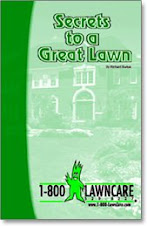Welcome to Lawn Talk.
Designed to answer any questions you have regarding fertilization, weed control and ornamental turf diseases. Be sure and scroll to the bottom of the page for helpful articles and past entries.
Monday, July 22, 2013
Summer Patch or Take All Patch
Lately we are beginning to see a few yards showing signs of "Summer" patch or "Take All" patch. This troublesome lawn affliction can be caused by several underlying factors; The following is a excerpt from the University of Arkansas research and extension office;
"Take all patch is caused by the fungus Gaeumannomyces graminia, the primary damage to turf occurs from root infections, but stolon's and rhizomes can also be infected. Stressed or weakened turf tends to be more susceptible to pathogen attack, especially during moist hot conditions of summer." (2013www.uaex.edu Take-All Patch)
As professionals we have to diagnose problems right after they first exhibit signs of multiplying. The problem with "Take All" patch is that it usually appears in hot summer months immediately after periods of rain, once the rain stops, within a few days the disease has done its damage, the lead up time is just not enough to diagnose and treat the disease until its too late.
Also, "Summer Patch or Take all patch" has been linked to other factors not associated with turf disease, for example some professionals believe summer patch is purely the result of extreme heat patterns causing the turf to stress, leaving dead top growth often in shallow areas or along mowing wheel lines, leaving the yard to look as if the areas that are affected are uniform in nature.
The only way to remedy the problem is two-fold, try and put as much concentrated water directly on the affected area, with a water hose if needed to try and have the lawn recover faster, and recognize your lawn is susceptible to "Take All" patch and apply a preventative fungicide early before the disease comes back again the next year. A fungicide can be applied after the fact, however once the disease spreads shortly after a rain period, the reaction time is not fast enough to forego damage.
There is some good news however and it applies to how well the lawn recovers after the next dormant cycle, according to the University of Texas A&M, the recovery rate based on diseased area as a whole and the amount of new grass that springs up the next year is promising and has shown a substantial yield in new grass coming back on damaged areas the next year. In other words not all the grass dies or looses it's ability to bounce back, offering some hope for the future. If you have any questions or think you have the above disease please contact Lawn Tech @ 972-346-2696
Subscribe to:
Post Comments (Atom)







No comments:
Post a Comment